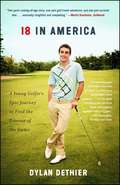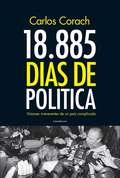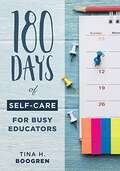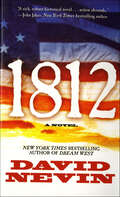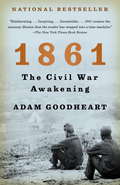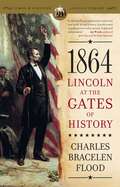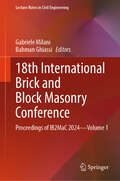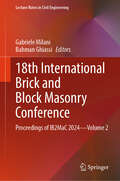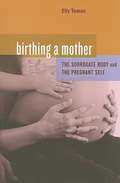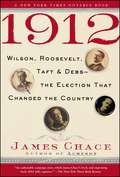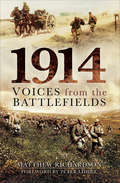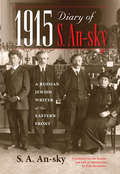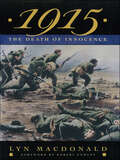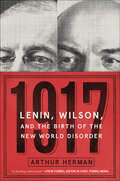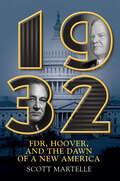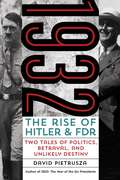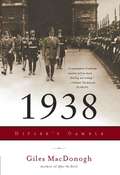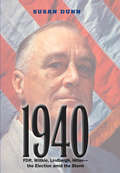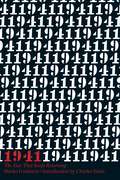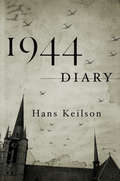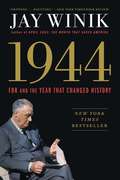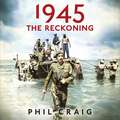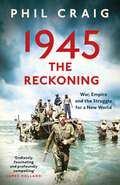- Table View
- List View
18 in America: A Young Golfer's Epic Journey to Find the Essence of the Game
by Dylan DethierA "winning" (Parade) and "well-conceived" (The New York Times) account of one teenager's solo trek to play golf in each of the lower forty-eight states--"two parts coming-of-age story, one part golf travel adventure, and one part survival test" (Golfweek).Shortly before his freshman year of college was set to begin, seventeen-year-old Dylan Dethier--hungry for an adventure beyond his small town--deferred his admission and, "like Jack Kerouac and Ken Kesey before him, packed his used car and meager life savings and set off to see and write about America" (ABC News/ Yahoo). His goal: play a round of golf in each of the lower forty-eight states. From a gritty municipal course in Flint, Michigan, to rubbing elbows with Phil Mickelson at Quail Hollow, Dylan would spend a remarkable year exploring the astonishing variety of the nation's golf courses--and its people. Over one year, thirty-five thousand miles, and countless nights alone in his dusty Subaru, Dylan showered at truck stops, slept with an ax under his seat, and lost his virginity, traveling "wherever the road took him, with golf as a vehicle for understanding America" (The New York Times). The result is a book that "would be considered fine work by any writer, let alone one so young" (Maine Edge).
18.885 días de política: Visiones irreverentes de un país complicado
by Carlos CorachUn interesante y lúcido relato de memorias de 18.885 días de actividadpolítica, que se leen en uno. Carlos Corach confiesa aquí que ha vivido (y sigue viviendo) una intensavida política: del desarrollismo al menemismo, del Colegio Nacional deBuenos Aires al Pacto de Olivos, el ex ministro del Interior repasa cadapeldaño, cada alegría, cada traspié y cada enseñanza de su carrera. Noevita tema alguno y subraya en todos una necesidad que hoy pareceolvidada: la del diálogo como herramienta principal de la política. DiceCorach en estas memorias como un apasionante manual de historiaargentina reciente: «Entendí que la política exige comprender y aceptarla diversidad de opiniones, que siempre hay que dialogar con aquelloscon quienes disentimos y que la relación con los adversarios,permanentes o circunstanciales, exige siempre el respeto mutuo».
180 Days Of Self-care For Busy Educators: (a 36-week Plan Of Low-cost Self-care For Teachers And Educators)
by Tina H. BoogrenRely on 180 Days of Self-Care for Busy Educators to help you lead a happier, healthier, more fulfilled life inside and outside of the classroom. With author Tina H. Boogren's guidance, you will work your way through thirty-six weeks of daily self-care strategies and techniques, each corresponding with a week of the school year. Weekly themes range from creativity and inspiration to relationships and time management for teachers and administrators.
1812: A Novel (The American Story)
by David NevinFrom the New York Times bestselling author David Nevin comes an atonishing historical novel of the War of 1812The war of 1812 would either make America a global power sweeping all the way to the Pacific--or break it into small pieces bound to mighty England. It was a second revolution of sorts to prove to the British that America had to be taken seriously. The principal actors in this drama were James and Dolley Madison, and Andrew and Rachel Jackson. Their courage and determination would shape America's destiny.At the Publisher's request, this title is being sold without Digital Rights Management Software (DRM) applied.
1861
by Adam GoodheartAs the United States marks the 150th anniversary of our defining national drama, 1861 presents a gripping and original account of how the Civil War began.1861 is an epic of courage and heroism beyond the battlefields. Early in that fateful year, a second American revolution unfolded, inspiring a new generation to reject their parents' faith in compromise and appeasement, to do the unthinkable in the name of an ideal. It set Abraham Lincoln on the path to greatness and millions of slaves on the road to freedom.The book introduces us to a heretofore little-known cast of Civil War heroes--among them an acrobatic militia colonel, an explorer's wife, an idealistic band of German immigrants, a regiment of New York City firemen, a community of Virginia slaves, and a young college professor who would one day become president. Adam Goodheart takes us from the corridors of the White House to the slums of Manhattan, from the mouth of the Chesapeake to the deserts of Nevada, from Boston Common to Alcatraz Island, vividly evoking the Union at this moment of ultimate crisis and decision.From the Hardcover edition.
1864
by Charles Bracelen FloodIn a masterful narrative, historian and biographer Charles Bracelen Flood brings to life the drama of Lincoln's final year, in which he oversaw the last campaigns of the Civil War, was reelected as president, and laid out his majestic vision for the nation's future in a reunified South and in the expanding West.
18th International Brick and Block Masonry Conference: Proceedings of IB2MaC 2024—Volume 1 (Lecture Notes in Civil Engineering #613)
by Gabriele Milani Bahman GhiassiThis book highlights the latest advances, innovations, and applications in the field of masonry structures and constructions, as presented by leading international researchers at the 18th International Brick and Block Masonry Conference (IB2MaC), held in Birmingham, UK, on July 21–24, 2024. Conference topics include architecture with masonry, analysis of masonry structures, bricks and blocks, mortars, repair, strengthening and retrofitting, conservation of historical heritage, new construction techniques, seismic engineering, durability and deterioration of materials, energy efficiency, AI, and masonry. The contributions, which were selected by means of a rigorous international peer-review process, present a wealth of exciting ideas that will open novel research directions and foster multidisciplinary collaboration among different specialists.
18th International Brick and Block Masonry Conference: Proceedings of IB2MaC 2024—Volume 2 (Lecture Notes in Civil Engineering #614)
by Gabriele Milani Bahman GhiassiThis book highlights the latest advances, innovations, and applications in the field of masonry structures and constructions, as presented by leading international researchers at the 18th International Brick and Block Masonry Conference (IB2MaC), held in Birmingham, UK, on July 21–24, 2024. Conference topics include architecture with masonry, analysis of masonry structures, bricks and blocks, mortars, repair, strengthening and retrofitting, conservation of historical heritage, new construction techniques, seismic engineering, durability and deterioration of materials, energy efficiency, AI, and masonry. The contributions, which were selected by means of a rigorous international peer-review process, present a wealth of exciting ideas that will open novel research directions and foster multidisciplinary collaboration among different specialists.
19 Steps Up the Mountain
by Joseph P. BlankIt is the story of Dorothy and Bob DeBolt, who could not resist the appeal of children no one else wanted. Children of different races and nationalities, children with seemingly hopeless physical handicaps and bleak futures. It is the story of the children themselves, each learning what it meant to be loved, and what it was to overcome the most heart rending obstacles. Two parents. Nineteen children. And the single most unforgettable story that will ever leave you with mist in your eyes and joy in your heart. "A tonic for cynical and disheartened readers...This book tells clearly what it takes to be successful parents, especially when J.R.-a blind paraplegic-conquers his fear and makes it up the 19-step staircase 'mountain' alone"
1912: Wilson, Roosevelt, Taft & Debs - the Election That Changed the Country
by James Chace Ellen R. SasaharaBeginning with former president Theodore Roosevelt's return in 1910 from his African safari, Chace brilliantly unfolds a dazzling political circus that featured four extraordinary candidates. When Roosevelt failed to defeat his chosen successor, William Howard Taft, for the Republican nomination, he ran as a radical reformer on the Bull Moose ticket. Meanwhile, Woodrow Wilson, the ex-president of Princeton, astonished everyone by seizing the Democratic nomination from the bosses who had made him New Jersey's governor. Most revealing of the reformist spirit sweeping the land was the charismatic socialist Eugene Debs, who polled an unprecedented one million votes. Wilson's "accidental" election had lasting impact on America and the world. The broken friendship between Taft and TR inflicted wounds on the Republican Party that have never healed, and the party passed into the hands of a conservative ascendancy that reached its fullness under Reagan and George W. Bush. Wilson's victory imbued the Democratic Party with a progressive idealism later incarnated in FDR, Truman, and LBJ. 1912 changed America.
1914: Voices from the Battlefields
by Matthew RichardsonThe opening battles of WWI&’s Western Front and the world-changing advances in warfare are reexamined through eyewitness accounts from the trenches. The 1914 campaign of World War I, sparked by the German Army&’s invasion of Luxembourg, Belgium, and France, marked a watershed in military history. Advances in weaponry forced both sides to take to the earth in what became a grueling standoff of trench warefare. In a bizarre mix of ancient and modern, some of the last cavalry charges took place in the same theatre in which armoured cars, motorcycles and aeroplanes were beginning to make their presence felt. These dramatic developments were recorded in graphic detail by soldiers who were there in the trenches themselves. Now, with the benefit of these firsthand accounts, historian Matthew Richardson offers a thoroughgoing reassessment of the 1914 campaign. His vivid narrative emphasises the perspective of the private soldiers and junior officers of the British Army and includes full colour plates containing over one hundred illustrations. 1914: Voices from the Battlefields was a Britain At War Magazine Book of the Month in February 2014.
1915 Diary of S. An-sky: A Russian Jewish Writer at the Eastern Front (Encounters: Explorations in Folklore and Ethnomusicology)
by S. A. An-SkyThe WWI diary of the Russian Jewish activist and author of The Dybbuk presents &“an unforgettable portrait of life, culture, and destruction&” (Eugene Avrutin, author of Jews and the Imperial State). By the outbreak of World War I, S. An-sky was a well-known writer, a longtime revolutionary, and an ethnographer who pioneered the collection of Jewish folklore in Russia's Pale of Settlement. In 1915, An-sky took on the assignment of providing aid and relief to Jewish civilians trapped under Russian military occupation in Galicia. As he made his way through the shtetls there, close to the Austrian frontlines, he kept a diary of his encounters and impressions. In his diary, An-sky describes conversations with wounded soldiers in hospitals, fellow Russian and Jewish aid workers, and Jewish civilians living on the Eastern Front. He recorded the brutality and violence against the civilian population, the complexities of interethnic relations, the practices and limitations of philanthropy and medical care, Russification policies, and antisemitism. In the late 1910s, An-sky used his diaries as raw material for a lengthy memoir in Yiddish, published under the title The Destruction of Galicia. Although most of An-sky&’s original diaries were lost, two fragments are preserved in the Russian State Archive of Literature and Art. Translated and annotated here by Polly Zavadivker, these fragments convey An-sky's vivid perceptions and enlightening insights.
1915: The Death of Innocence
by Lyn MacdonaldLyn Macdonald's 1915: The Death of Innocence is a uniquely compelling blend of military history and poignant memories of the fighters who survived the ordeal. By Christmas 1915, the wild wave of enthusiasm that had sent men flocking to join up a few months earlier had begun to tail off, and though the Regulars of the original Expeditionary Force had suffered 90 percent casualties, most, particularly the soldiers themselves, still believed that 1915 would see the breaking of the deadlock. Their hopes were shattered on the bloody battlefields at Neuve Chapelle, at Ypres, at Loos, and far away on the shores of Gallipoli. Generals failed to understand the importance of heavy howitzers and machine guns, convinced that wars were won by the cavalry. They could not imagine a war in which hundreds of advancing troops could be wiped out in minutes by machine-gun fire. As disillusionment began to set in and grim resolve replaced easy optimism, innocence was among the casualties in the trenches that ran through the Flanders swamps. The story of 1915 is stark, brutal, frank, sometimes painfully funny, always human. Above all, it is history from the ground up, told from the point of view of the men themselves. Never before has any writer collected so many firsthand accounts of the experiences of ordinary soldiers, through diaries, letters, and interviews with survivors--and it is the dogged heroism and sardonic humor of the soldiers that shine through the pages of Lyn Macdonald's epic narrative.
1917: Lenin, Wilson, and the Birth of the New World Disorder
by Arthur HermanIn this dual biography, New York Times bestselling author Arthur Herman brilliantly reveals how Lenin and Wilson rewrote the rules of modern geopolitics. In April 1917, Woodrow Wilson—champion of American democracy but also of segregation, advocate for free trade and a new world order based on freedom and justice—thrust the United States into the First World War in order to make the &“world safe for democracy&”—only to see his dreams for a liberal international system dissolve into chaos, bloodshed, and betrayal. That October, Vladimir Lenin—communist revolutionary and advocate for class war and &“dictatorship of the proletariat&”—would overthrow Russia&’s earlier democratic revolution that had toppled the powerful czar, all in the name of liberating humanity—and instead would set up the most repressive totalitarian regime in history, the Soviet Union. Prior to and through the end of World War I, countries marched into war only to advance or protect their national interests. After World War I, countries began going to war over ideas. Together Lenin and Wilson unleashed the disruptive ideologies that would sweep the globe, from nationalism and globalism to Communism and terrorism, and that continue to shape our world today. Our new world disorder is the legacy left by Wilson and Lenin, and their visions of the perfectibility of man. More than a century later, we still sit on the powder keg they first set the detonator to, through war and revolution.&“Deeply researched and engagingly written, this is a gripping account of great battles won and lost, of a triumphant war followed by a failed peace, and of clashing ideologies that shaped a century.&” —Robert Kagan
1931 Desh ya Prem?: १९३१ देश या प्रेम?
by Satya Vyas1931 देश या प्रेम एक रोमांचक ऐतिहासिक पुस्तक है जो 20वीं सदी के शुरुआती भारतीय स्वतंत्रता आंदोलन के दौरान घटित घटनाओं पर आधारित है। यह सत्य व्यास द्वारा लिखित कृति क्रांतिकारी नेताओं के जीवन, भावनाओं, और समाज पर उनके प्रभाव को दर्शाती है, जिसमें गांधीजी का नमक सत्याग्रह और भगत सिंह व उनके साथियों की शहादत के घटनाक्रम शामिल हैं। पुस्तक क्रांति के मानवीय पहलू को उजागर करती है, नायकों की मानसिक, सामाजिक और पारिवारिक परिस्थितियों पर ध्यान केंद्रित करती है, और भारतीय इतिहास तथा स्वतंत्रता आंदोलन के कम ज्ञात किस्सों में रुचि रखने वाले किसी भी व्यक्ति के लिए एक अनिवार्य पठन है।
1932: FDR, Hoover, and the Dawn of a New America
by Scott MartelleA fascinating behind-the-scenes look at a year in American history that still resonates today, 1932: FDR, Hoover, and the Dawn of a New America tells the story of a battered nation fighting for its own future amid the depths of the Great Depression. At the start of 1932, the nation&’s worst economic crisis has left one-in-four workers without a job, countless families facing eviction, banks shutting down as desperate depositors withdraw their savings, and growing social and political unrest from urban centers to the traditionally conservative rural heart of the country. Amid this turmoil, a political decision looms that will determine the course of the nation. It is a choice between two men with very diferent visions of America: Incumbent Republican Herbert Hoover with his dogmatic embrace of small government and a largely unfettered free market, and New York&’s Democratic Governor Franklin Delano Roosevelt and his belief that the path out of the economic crisis requires government intervention in the economy and a national sense of shared purpose. Now veteran journalist Scott Martelle provides a gripping narrative retelling of that vitally significant year as social and political systems struggled under the weight of the devastating Dust Bowl, economic woes, rising political protests, and growing demand for the repeal of Prohibition. That November, voters overwhelmingly rejected decades of Republican rule and backed Roosevelt and his promise to redefine the role of the federal government while putting the needs of the people ahead of the wishes of the wealthy. Deftly told, this illuminating work spotlights parallel events from that pivotal year and brings to life figures who made headlines in their time but have been largly forgotten today. Ultimately, it is the story of a nation that, with the help of a leader determined to unite and inspire, took giant steps toward a new America.
1932: The Rise of Hitler and FDR--Two Tales of Politics, Betrayal, and Unlikely Destiny
by David PietruszaTwo Depression-battered nations confronted destiny in 1932, going to the polls in their own way to anoint new leaders, to rescue their people from starvation and hopelessness. America would elect a Congress and a president ebullient aristocrat Franklin Roosevelt or tarnished Wonder Boy Herbert Hoover. Decadent, divided Weimar Germany faced two rounds of bloody Reichstag elections and two presidential contests doddering reactionary Paul von Hindenburg against rising radical hate-monger Adolf Hitler. The outcome seemed foreordained unstoppable forces advancing upon crumbled, disoriented societies. A merciless Great Depression brought greater perhaps hopeful, perhaps deadly transformation: FDR s New Deal and Hitler s Third Reich. But neither outcome was inevitable. Readers enter the fray through David Pietrusza s page-turning account: Roosevelt s fellow Democrats may yet halt him at a deadlocked convention. 1928 s Democratic nominee, Al Smith, harbors a grudge against his one-time protege. Press baron William Randolph Hearst lays his own plans to block Roosevelt s ascent to the White House. FDR s politically-inspired juggling of a New York City scandal threatens his juggernaut. In Germany, the Nazis surge at the polls but twice fall short of Reichstag majorities. Hitler, tasting power after a lifetime of failure and obscurity, falls to Hindenburg for the presidency also twice within the year. Cabals and counter-cabals plot. Secrets of love and suicide haunt Hitler. Yet guile and ambition may yet still prevail. 1932 s breathtaking narrative covers two epic stories that possess haunting parallels to today s crisis-filled vortex. It is an all-too-human tale of scapegoats and panaceas, class warfare and racial politics, of a seemingly bottomless depression, of massive unemployment and hardship, of unprecedented public works/infrastructure programs, of business stimulus programs and damaging allegations of political cronyism, of waves of bank failures and of mortgages foreclosed, of Washington bonus marches and Berlin street fights, of once-solid financial empires collapsing seemingly overnight, of rapidly shifting social mores, and of mountains of irresponsible international debt threatening to crash not just mere nations but the entire global economy. It is the tale of spell-binding leaders versus bland businessmen and out-of-touch upper-class elites and of two nations inching to safety but lurching toward disaster. It is 1932 s nightmare with lessons for today. "
1938: Hitler's Gamble
by Giles MacdonoghIn this masterful narrative, acclaimed historian Giles MacDonogh chronicles Adolf Hitler's consolidation of power over the course of one year. Until 1938, Hitler could be dismissed as a ruthless but efficient dictator, a problem to Germany alone; after 1938 he was clearly a threat to the entire world. It was in 1938 that Third Reich came of age. The Führer brought Germany into line with Nazi ideology and revealed his plans to take back those parts of Europe lost to "Greater Germany" after the First World War. From the purging of the army in January through the Anschluss in March, from the Munich Conference in September to the ravages of Kristallnacht in November, MacDonogh offers a gripping account of the year Adolf Hitler came into his own and set the world inexorably on track to a cataclysmic war.
1940: FDR, Willkie, Lindbergh, Hitler—the Election amid the Storm
by Susan DunnA history of the 1940 U.S. presidential election, when bitterly divided Americans debated the fate of the nation and the world. In 1940, against the explosive backdrop of the Nazi onslaught in Europe, two farsighted candidates for the U.S. presidency—Democrat Franklin D. Roosevelt, running for an unprecedented third term, and talented Republican businessman Wendell Willkie—found themselves on the defensive against American isolationists and their charismatic spokesman Charles Lindbergh, who called for surrender to Hitler's demands. In this dramatic account of that turbulent and consequential election, historian Susan Dunn brings to life the debates, the high-powered players, and the dawning awareness of the Nazi threat as the presidential candidates engaged in their own battle for supremacy. 1940 not only explores the contest between FDR and Willkie but also examines the key preparations for war that went forward, even in the midst of that divisive election season. The book tells an inspiring story of the triumph of American democracy in a world reeling from fascist barbarism, and it offers a compelling alternative scenario to today&’s hyperpartisan political arena, where common ground seems unattainable. &“Anyone today who believes that U.S. involvement and the ultimate Allied triumph in World War II was inevitable must read this important history."—Michael Beschloss, New York Times bestselling author of Presidential Courage &“Susan Dunn, a prolific and outstanding historian, has crafted a fast-paced, serious, and extraordinarily well-researched book about the events surrounding the pivotal 1940 election. Her main characters…come brilliantly to life. I could hardly put the book down.&”—James T. Patterson, author of Bancroft Prize-winning Grand Expectations: The United States, 1945-1974
1941: The Year That Keeps Returning
by Charles Simic Michael Gable Slavko GoldsteinA New York Review Books OriginalThe distinguished Croatian journalist and publisher Slavko Goldstein says, "Writing this book about my family, I have tried not to separate what happened to us from the fates of many other people and of an entire country." 1941: The Year That Keeps Returning is Goldstein's astonishing historical memoir of that fateful year--when the Ustasha, the pro-fascist nationalists, were brought to power in Croatia by the Nazi occupiers of Yugoslavia. On April 10, when the German troops marched into Zagreb, the Croatian capital, they were greeted as liberators by the Croats. Three days later, Ante Pavelić, the future leader of the Independent State of Croatia, returned from exile in Italy and Goldstein's father, the proprietor of a leftist bookstore in Karlovac--a beautiful old city fifty miles from the capital--was arrested along with other local Serbs, communists, and Yugoslav sympathizers. Goldstein was only thirteen years old, and he would never see his father again. More than fifty years later, Goldstein seeks to piece together the facts of his father's last days. The moving narrative threads stories of family, friends, and other ordinary people who lived through those dark times together with personal memories and an impressive depth of carefully researched historic details. The other central figure in Goldstein's heartrending tale is his mother--a strong, resourceful woman who understands how to act decisively in a time of terror in order to keep her family alive. From 1941 through 1945 some 32,000 Jews, 40,000 Gypsies, and 350,000 Serbs were slaughtered in Croatia. It is a period in history that is often forgotten, purged, or erased from the history books, which makes Goldstein's vivid, carefully balanced account so important for us today--for the same atrocities returned to Croatia and Bosnia in the 1990s. And yet Goldstein's story isn't confined by geographical boundaries as it speaks to the dangers and madness of ethnic hatred all over the world and the urgent need for mutual understanding.
1944 Diary
by Damion Searls Hans Keilson[1944 Diary] is a deeply personal account, made even more remarkable that it was written during World War II and the horrors of the Holocaust . . . A moving and fascinating read." —Library JournalIn 2010, FSG published two novels by the German- Jewish writer Hans Keilson: Comedy in a Minor Key—written in 1944 while Keilson was in hiding in the Netherlands, first published in German in 1947, and never before in English—and The Death of the Adversary, begun in 1944 and published in 1959, also in German. With their Chekhovian sympathy for perpetrators and bystanders as well as for victims and resisters, Keilson’s novels were, as Francine Prose said on the front page of The New York Times Book Review, “masterpieces” by “a genius” on her list of “the world’s very greatest writers.” Keilson was one hundred years old, alive and well and able to enjoy his belated fame.1944 Diary, rediscovered among Keilson’s papers shortly after his death, covers nine months he spent in hiding in Delft with members of a Dutch resistance group, having an affair with a younger Jewish woman in hiding a few blocks away and striving to make a moral and artistic life for himself as the war and the Holocaust raged around him. For readers familiar with Keilson’s novels as well as those new to his work, this diary is an incomparable spiritual X-ray of the mind and heart behind the art: a record of survival and creativity in what Keilson called “the most critical year of my life.”Offering further insight into Keilson are the sonnets he wrote for his lover, Hanna Sanders, which appear in translation at the back of this volume.
1944: FDR and the Year That Changed History
by Jay WinikThe year 1944, which determined the outcome of World War II and put intense pressure on the ailing yet determined President Roosevelt, is brought to vivid life in &“gripping&” (The New York Times Book Review) detail in this New York Times bestseller. 1944 was a year that could have stymied the Allies and cemented Hitler&’s waning power. Instead, it saved those democracies—but with a fateful cost. Now, in a &“complex history rendered with great color and sympathy&” (Kirkus Reviews, starred review), Jay Winik captures the epic images and extraordinary history &“with cinematic force&” (Time). 1944 witnessed a series of titanic events: FDR at the pinnacle of his wartime leadership as well as his reelection, the unprecedented D-Day invasion, the liberation of Paris, and the tumultuous conferences that finally shaped the coming peace. But millions of lives were at stake as President Roosevelt learned about Hitler&’s Final Solution. Just as the Allies were landing in Normandy, the Nazis were accelerating the killing of millions of European Jews. Winik shows how escalating pressures fell on an infirm Roosevelt, who faced a momentous decision. Was winning the war the best way to rescue the Jews? Or would it get in the way of defeating Hitler? In a year when even the most audacious undertakings were within the world&’s reach, one challenge—saving Europe&’s Jews—seemed to remain beyond Roosevelt&’s grasp. &“This dramatic account highlights what too often has been glossed over—that as nobly as the Greatest Generation fought under FDR&’s command, America could well have done more to thwart Nazi aggression&” (The Boston Globe). Destined to take its place as one of the great works of World War II, 1944 is the first book to retell these events with moral clarity and a moving appreciation of the extraordinary actions of many extraordinary leaders.
1945: War, Empire and the Struggle for a New World
by Phil CraigAs the fate of the world is decided, so too is that of the British, Dutch and French empires. In India a generation committed to independence must decide whether to support 'the Raj' or fight alongside the Japanese. One military family is bitterly divided. Will it be the brother who serves under British command, or the one who follows Subhas Chandra Bose and his Indian National Army, who goes on to help build a new and free India? In Borneo a little known Australian special forces campaign - secretly controlled from London - goes horribly wrong as questions are asked about whether its true purpose is military or imperial. And in Indochina and the East Indies British Generals free and arm Japanese prisoners of war and use them in savage campaigns that aim to put colonial rulers back into their palaces.Clearing away the haze of nostalgia, many uncomfortable truths emerge - but so too does a humane and balanced exploration of what victory in the Second World War truly means.
1945: War, Empire and the Struggle for a New World
by Phil CraigAs the fate of the world is decided, so too is that of the British, Dutch and French empires. In India a generation committed to independence must decide whether to support 'the Raj' or fight alongside the Japanese. One military family is bitterly divided. Will it be the brother who serves under British command, or the one who follows Subhas Chandra Bose and his Indian National Army, who goes on to help build a new and free India? In Borneo a little known Australian special forces campaign - secretly controlled from London - goes horribly wrong as questions are asked about whether its true purpose is military or imperial. And in Indochina and the East Indies British Generals free and arm Japanese prisoners of war and use them in savage campaigns that aim to put colonial rulers back into their palaces.Clearing away the haze of nostalgia, many uncomfortable truths emerge - but so too does a humane and balanced exploration of what victory in the Second World War truly means.
1945: War, Empire and the Struggle for a New World
by Phil CraigAs the fate of the world is decided, so too is that of the British, Dutch and French empires. In India a generation committed to independence must decide whether to support 'the Raj' or fight alongside the Japanese. One military family is bitterly divided. Will it be the brother who serves under British command, or the one who follows Subhas Chandra Bose and his Indian National Army, who goes on to help build a new and free India? In Borneo a little known Australian special forces campaign - secretly controlled from London - goes horribly wrong as questions are asked about whether its true purpose is military or imperial. And in Indochina and the East Indies British Generals free and arm Japanese prisoners of war and use them in savage campaigns that aim to put colonial rulers back into their palaces.Clearing away the haze of nostalgia, many uncomfortable truths emerge - but so too does a humane and balanced exploration of what victory in the Second World War truly means.
